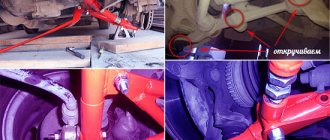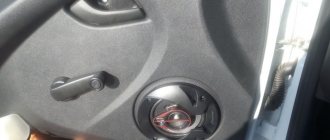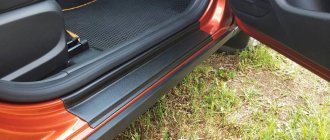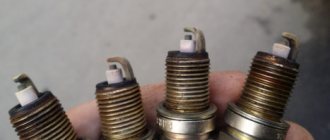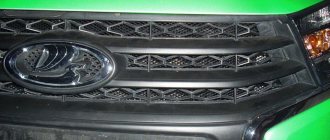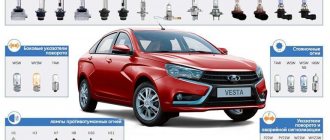Almost all modern cars, especially those belonging to the B-class, suffer from insufficient noise insulation in the area of the wheel arches. Lada Vesta SW is also no exception. In an attempt to save money and offer the buyer a better price, manufacturers reduce the cost of the design as much as possible. To get rid of this problem, you can simply install the fender liners of the Lada Vesta SV.
If you remember the first Lada models, you understand that almost all of them had plastic fender liners as a mandatory attribute. At that time, this was not just some useless tuning, but a really necessary modification to the car. Why? Read the article further.
Which fender liners should I choose for the Lada Vesta SV?
The main criteria for choosing lockers are as follows:
- factor No. 1: dirt should not settle on the surface, and the structure itself can be easily washed and cleaned;
- factor No. 2: partial protection of the body from corrosion, oxidation of the metal surface (factory treatment of wheel arches with anti-gravel is not enough, because during the operation of the car sand, dirt, and crushed stone fly out from under the wheels, damaging the paintwork);
- factor No. 3: additional sound insulation of the interior, which is so lacking in domestic cars.
Locker functions
Despite the fact that AvtoVAZ installs standard protection on Vesta from the factory, most owners install additional lockers. The purpose of lockers is to protect arches and body parts from impact.
The fender liners perform the following functions:
- This is protection against stones;
- Protection from dirt, sand;
- This is additional sound insulation.
The service life varies; the cheaper it is, the higher the likelihood of buying a low-quality part. The operating time, of course, should not be assessed only by these criteria. The operating area, climatic conditions, and driver’s driving style play a huge role.
Main types of fender liner
- Universal front and rear fender liners for Lada Vesta: manufactured by third-party manufacturers. The material used is plastic, most often of low quality. During prolonged use in the cold, the polymer bursts, cracks form, and deformation occurs. Relatively low cost is the main feature of “station wagons”.
- Branded standard fender liners (article 8454543565) are made with the addition of polyethylene. The material withstands high and low temperatures well and is not subject to deformation or corrosion. The service life of such lockers is many times longer than universal ones. At the same time, the price is 15% more expensive than analogues.
- Felt fender liners (liquid): A new type of wheel arch protection is a mixture of rubber and resin. Applied to the metal surface on the inside of the wing. A certain protective layer is formed. The service life is 5 – 6 years, after which it is necessary to update the “mastic”. High cost is one of the main disadvantages.
- Protection with noise insulation and vibration insulation layer.
Related link:
Which is better Lada Vesta or Lada X-Ray
Fly swatter
With this element, owners try to protect the car from chips and other damage. But a fly swatter does not protect against them; chips still appear. The attachment points of the fly swatter are usually subject to corrosion. It does not matter how the installation takes place (armored film, rubber bands, spacers).
In any case, when moving, everything moves, sand and reagents penetrate everywhere. This is wasted money and damage to the hood. The paint may also fade unevenly.
Installation of fender liners on Lada Vesta
Preparation of the workplace, necessary tools
- a flat-head, Phillips-head screwdriver;
- TORX wrench with socket set;
- rags;
- liquid for removing rust deposits WD – 40;
- hammer;
- plastic caps;
- a new mudguard if the old one is damaged.
Step-by-step instructions for installing the front fender liner
- We hang the front of the car with a hydraulic jack.
- Unscrew the bolts and remove the wheel.
- We rinse the arch cavity from the inside with water. Dry thoroughly.
- We unscrew the four bolts and the plug that holds the standard mudguard to the body.
- We apply the locker to the body, mark points - places where holes for self-tapping screws are likely to be drilled. We treat them with Litol lubricant to prevent the formation of corrosion.
- We screw in the screws and fix the mudguard.
- We put on the protection, the wheel on the splines, and tighten the bolts.
Installation of the locker yourself is completed. Installation of the rear fender liner is carried out according to similar regulations.
Net
It is mounted on top of the bumper, and exists in 2 versions:
- Aluminum.
- Steel.
In the second case, the mesh will begin to rust over time, and you will get a rusty spot in front of the car for a lot of money. It will be much cheaper to install a mesh on the inside of the bumper.
Even if it rusts, it will not be visible. It performs its protection function and costs several times less.
Conclusion
The procedure for installing fender liners on a Lada Vesta car yourself is not at all complicated. The task can be accomplished even by an inexperienced car enthusiast. If any difficulties arise during installation, please contact a service station for help.
Car service workers strongly recommend purchasing branded lockers and then installing them, since it is the “originals” that guarantee full compatibility with the body structure of your vehicle.
As an alternative, consider purchasing plastic fender liners.
What to look for when choosing?
When choosing lockers for the Lada Vesta, special attention should be paid to the thickness of the material from which they are made; a part that is too thin will not last long. Check that the fender liners have sufficient flexibility and ductility, and that they do not have complex installation patterns on the vehicle. The material from which the part is made plays an important role. Check carefully that:
- the fender liner completely covered the most exposed and vulnerable parts of the Lada Vesta body in terms of corrosion;
- select lockers so that they fit the standard fasteners that are present in the body of the Lada Vesta; it is extremely undesirable to drill holes in the car again.
Reviews
| № | Positive |
| 1 | Andrey (Avtodrom): after buying the car I installed plastic lockers, I’ve been driving for three years without any complaints. |
| 2 | Sergey (Avtotema): I’m happy with the lockers, they’re a little noisy on gravel, but this is compensated by the low price. |
| 3 | Kirill (Autoreview): installed original lockers on Lada Vesta. The price was steep, but the quality was good. |
| 4 | Alexey (Avtoria): the fender liners have been installed for the second year, they fit tightly and are sealed. |
| 5 | Alexander (Drom): installed the lockers on his own, completed it in a total of an hour and a half. |
| 6 | Stanislav (Driving): the protection is good, practical, and does not deform in the cold. |
| 7 | Vasily Alekseevich (“5th wheel”): Three years have passed since the installation of the lockers, there are no complaints. |
| Negative | |
| 8 | Vitaly (Avtotema): the plastic locker burst in winter, replaced it with a new one. |
| 9 | Svyatoslav (Otzovik.net): the price of original lockers is unreasonably high. |
| 10 | Vlad (ProAvto): there are no particular complaints about the plastic, but it creaks in severe frost. |
Related link:
Crankcase protection Lada Vesta: review, installation, selection recommendations
Winter radiator protection
The plugs are made of plastic or soft material (fabric, tarpaulin). There is no need to do this. This may be justified if you live in the far north, where there are very severe frosts. If this is the middle zone, then closing the radiator for the winter is simply nonsense. You have a modern car with a normal cooling system. If it's working, then you don't need these things.
It is known that the car gets hot with them, and can cause the engine to overheat. If you work in a taxi or as a sales manager, buy a special blanket. It will prevent the engine from cooling quickly and will save some fuel.
Body edge protection
Many car enthusiasts try to protect body edges from impacts and damage, such as doors. In this case, a special film is glued or other elements are put on. In the first case, the film does not spoil the view and provides protection.
Experts have different opinions on external seals. There will be protection for a while, but then salt, dirt, reagents, and moisture will become clogged. The result is corrosion. This is not entirely the right decision. It is better to hold the door while opening.
Manufacturers and prices
When purchasing or placing an order, you need to clarify the body of your Vesta to avoid confusion.
3 years and 5 months ago / Tuning
AVTOVAZ, following long-standing traditions, did not install rear fender liners on the Vesta model. The arch is protected only by a small splash guard installed at its end. Traditionally, nothing will stop new owners from installing fender liners in pursuit of additional sound insulation and cleanliness. But is there any benefit from lockers on this particular model?
Criterias of choice
They are quite simple. First, you need to visually evaluate the product for cracks, creases and other damage. You also need to pay attention to the thickness of the material so that it is not too thin (in this case, stones will easily pierce it). Afterwards, it would be a good idea to evaluate the plasticity. Naturally, it is not recommended to buy plastic goods - only from HDPE.
An example of fender liners for Vesta.
The configuration of the product must ensure protection of the most vulnerable areas of the wheel arches. It is also strongly recommended to buy only those fender liners that are fixed to standard fasteners in order to avoid drilling holes in the body. If they still had to be drilled, they must be treated with anticorrosive.
In addition, you should not focus on saving. High-quality fender liners for Vesta are not too expensive, so you won’t be able to save more than 300-400 rubles (on a set). But in a couple of years you will have to buy a new set.
Proper sound insulation of Lada car fender liner (how to do and reviews)
Proper sound insulation of Lada car fender liner (how to do and reviews)
In the interior of modern cars, the primary sources of noise are (in descending order): wheels, air flows flowing around the body when driving, engine, gearbox and exhaust system. To reduce wheel noise, it is recommended to carry out a set of measures, but it is better to start with the simplest thing - this is gluing the lockers (plastic covers of the wheel arches) with noise insulation.
It’s worth noting right away that the process of soundproofing the fender liner with your own hands is similar for all Lada models (Granta, Kalina, Priora, Largus, Niva 4x4, Vesta or XRAY) and foreign-made cars.
To reduce noise from the road, you should soundproof not only the front fender liners, but also the rear ones. Moreover, rear lockers may not be installed by the manufacturer, but the majority of car enthusiasts believe that they need to be installed themselves (surveys: Granta/Priora/Kalina. Largus. Vesta).
How to glue fender liners for sound insulation
The first layer is a vibration-absorbing (mastic) material, which is designed to reduce vibrations of metal and plastic panels, with a foil front covering and a thickness of 2-4 mm:
- from ;
- from the Shumoff company - vibration dampers of the “M” or “Mix F” series.
You can also choose the appropriate vibration-proofing material yourself, for example, using this table:
The second layer is a soundproofing self-adhesive material. It is important that it has a closed-cell structure, does not absorb moisture at all, and is 4-10 mm thick (bitoplast and accent are not recommended):
- from ;
- from .
Using two types of material will minimize road noise in the cabin.
The process of refining car fender liner
- Remove the wheel arch liners;
- Degrease the inner surface of the fender liner, for example, with White Spirit;
- First glue it with vibration-absorbing material (heating it with a hairdryer and rolling the material over the surface with a hard roller).
and then soundproofing materials. Try to cover as much surface area as possible, but make sure that the material does not stick out anywhere or cover the mounting holes.
The process of soundproofing the fender liner is also shown in:
Reviews after soundproofing lockers
To show the approximate effect of soundproofing the wheel arches of a car, a stand was constructed. The speaker that reproduces road noise was covered:
- metal box;
- a box covered with vibration isolator;
- box, which is glued with vibration-absorbing and sound-proofing materials.
Test results can be viewed at:
Tests by ZaRulem magazine showed that installing fender liners (with shvi) reduces road noise. Using the Lada Vesta as an example, the noise level in the cabin decreased by 0.8-1.6 dB.
What is good about this modification of lockers?
- Save time. First of all, we reduce the noise from the wheels without disassembling the car interior;
- Efficiency. We make noise insulation from the outside, as close as possible to the noise source;
- Low price. We process a small area, which allows us to save on materials.
Do you think it makes sense to soundproof the fender liner or is it a waste of money and effort? Leave your feedback and observations. Let us remind you that to achieve the best result, it is recommended to carry out a set of measures aimed at soundproofing the interior. We recommend soundproofing the doors and installing additional seals.
https://xn--80aal0a.xn--80asehdb
Source: https://legkoe-delo.ru/remont-avtomobilya/automobile/91420-pravilnaya-shumoizolyatsiya-podkrylok-avtomobilej-lada-kak-sdelat-i-otzyvy
Accessories in the cabin
Many different accessories can be ordered from China, for example, chrome trims for plastic interior elements. I won’t talk about aesthetics; each driver has a personal view of beauty. Let's talk only about practicality. These elements are unsafe; they cause glare in the sun.
In a critical situation, the chrome trim can let the sun shine into the eyes, and the driver can get into an accident. Therefore, I do not recommend installing a lot of chrome accessories in the interior.
Fresheners
This is a safe element, but there is a question about its use. The first is a freshener in jars.
They come in different prices.
You need to remember 2 points:
- When tying it to the mirror, remember that the air freshener does not reach the windshield during fluctuations. If you tie it too low and then brake suddenly on the road, the fragrance can dangle a lot and break the glass.
- If a cheap air freshener leaks, or the flask itself unscrews and falls on the dashboard, then the plastic will be damaged.
A cheap fragrance if used incorrectly can lead to expensive repairs or replacement of interior elements.
Adapter ELM-327
Many people use it and know what it is. A useful thing, worth a penny. I recommend that every driver have it in their glove compartment. If an error pops up, you can easily read it and diagnose the car. But there are some disadvantages.
This device must not be left in the diagnostic socket as it consumes battery power. If you don’t drive often and the Lada Vesta is parked for a long time, the battery may be discharged.
The ELM 327 adapter has hidden functions - turning off the rear wiper, connecting roadside lighting, polite light and others. If you do not know how to use this device, you do not need to change any settings. There are many examples where owners tried to connect various functions, and then went to specialists and paid them money to get everything back. Don't do anything you don't understand.
